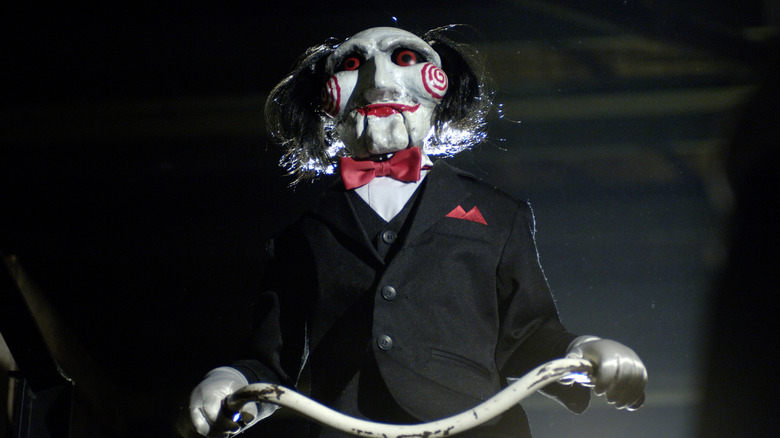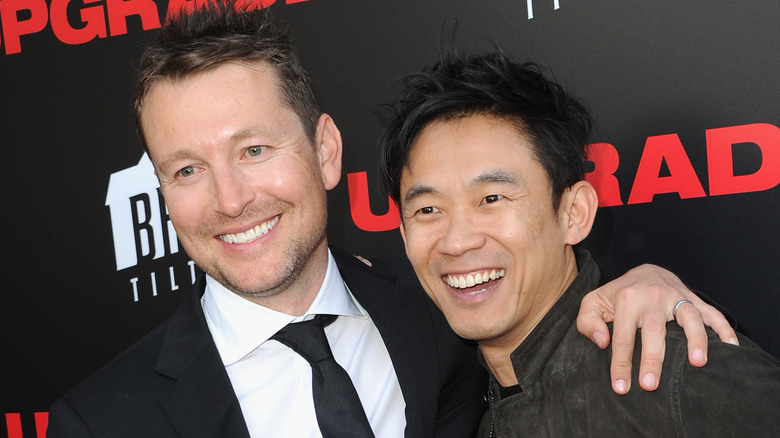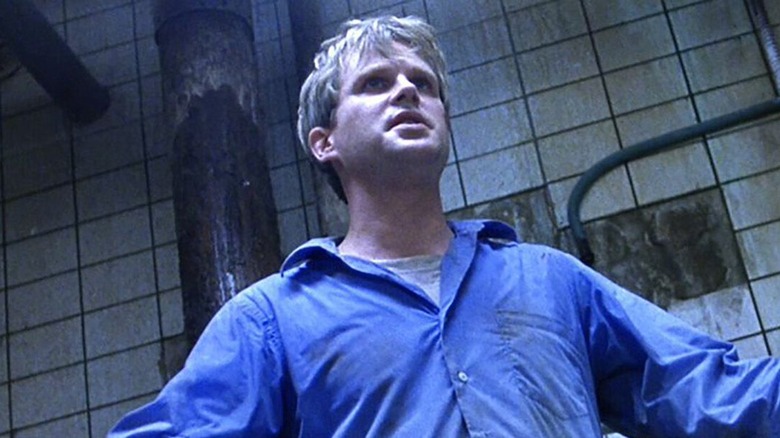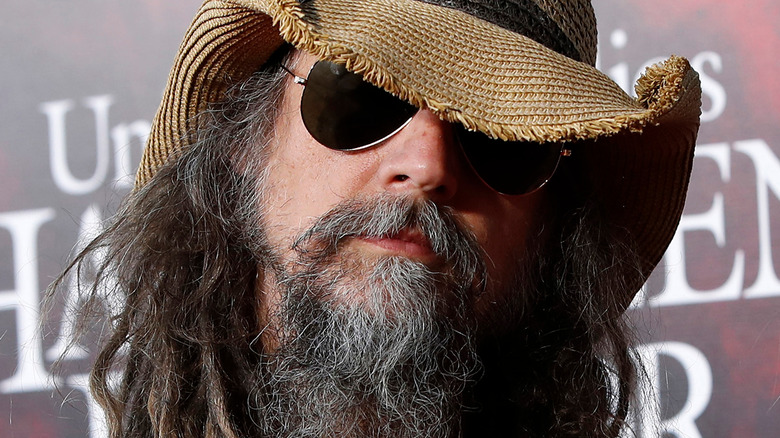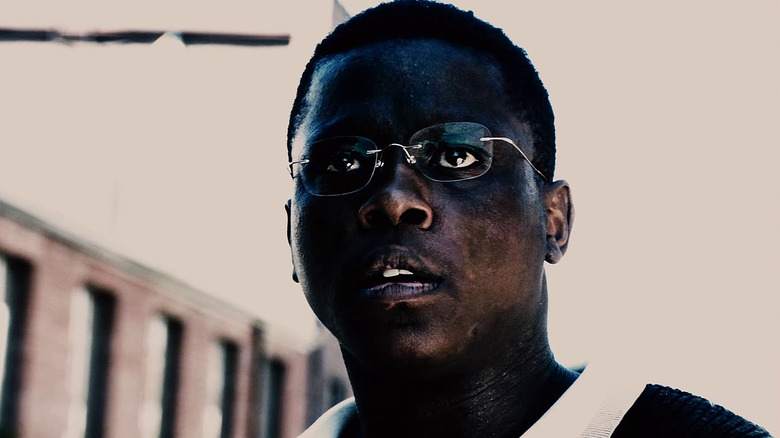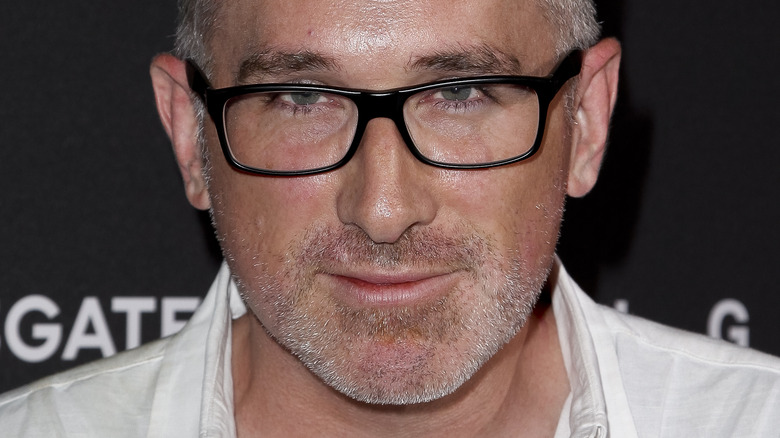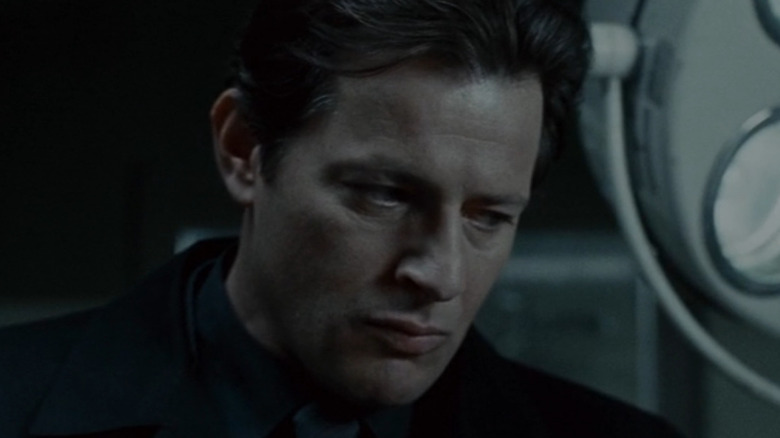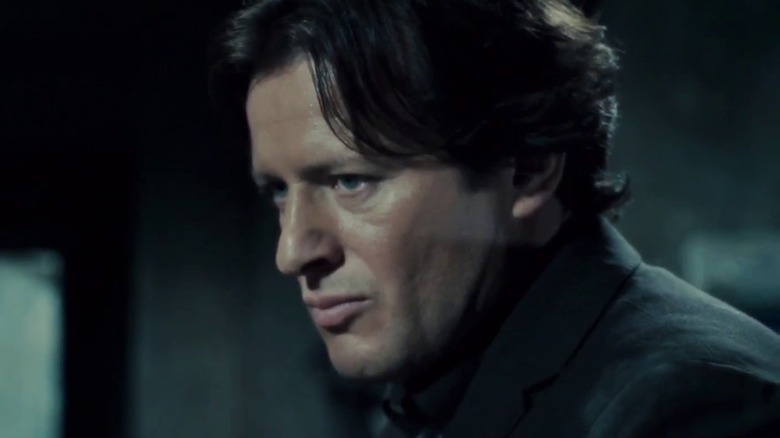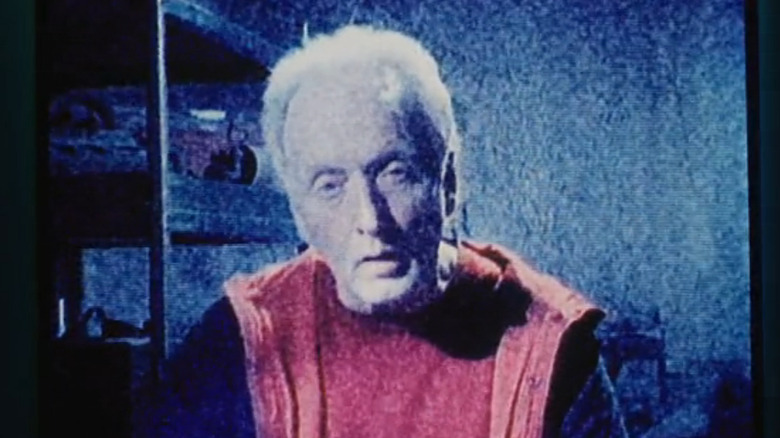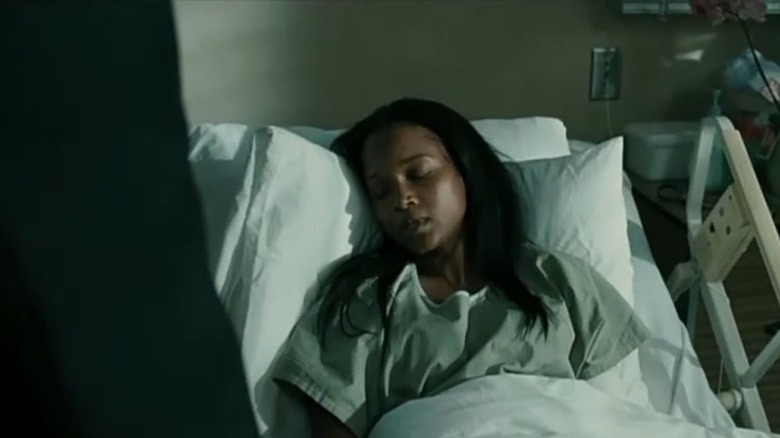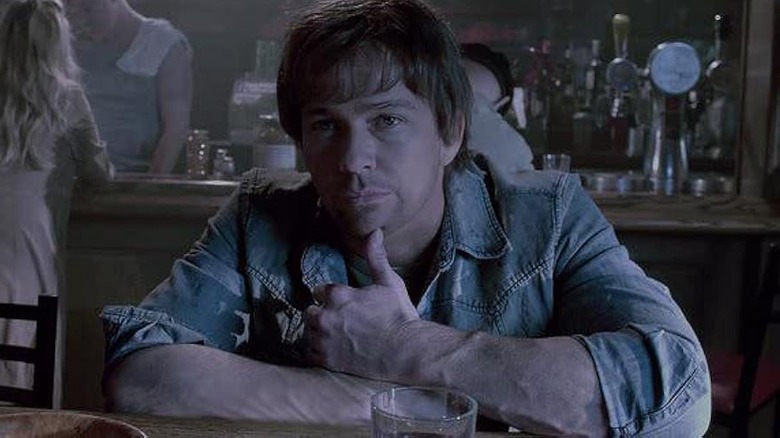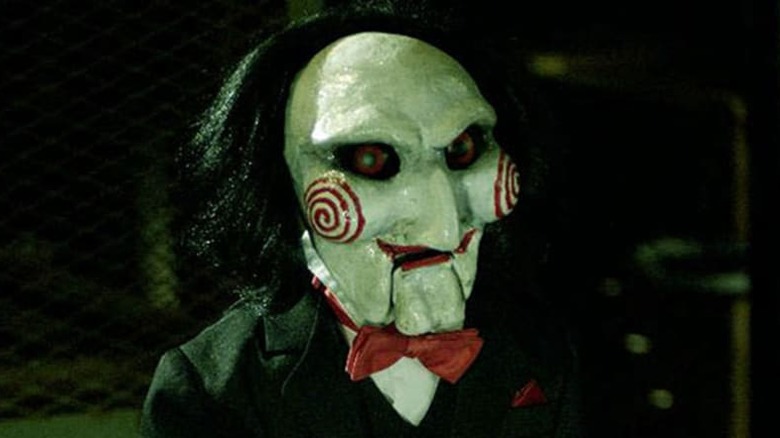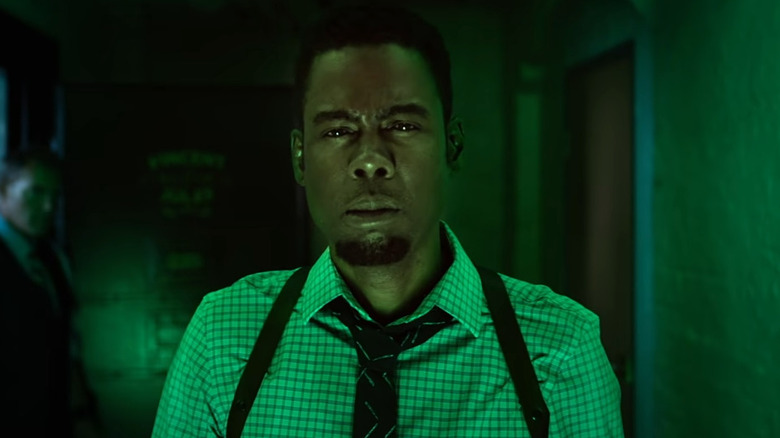Why Most Of The Saw Movies Were Originally Rated NC-17
At its core, the "Saw" franchise is a story about a man unhappy with his life and the world at large. John "Jigsaw" Kramer (Tobin Bell) is diagnosed with terminal cancer, and due to a cruel tragedy, his wife Jill loses the baby they were so desperately awaiting. This chain of events pushes Jigsaw to the dark side, where he takes his frustrations out on people he feels don't appreciate the gift of life. Disposable income and a talent for engineering allow him to start a reign of vengeance with elaborate death traps, a tricycle-riding puppet named Billy, and an iconic catchphrase — "I want to play a game."
The first movie, "Saw," kicked off the horror franchise with a bang. Since then, there have been nine core installments in the franchise, each one gorier than the last. Despite being one of the highest-grossing horror franchises ever, "Saw" has developed a reputation for being little more than a series about torture. With that in mind, it shouldn't be a surprise that most of the films barely escaped the dreaded NC-17 rating.
An NC-17 rating means no one under the age of 17 is permitted to see the movie in theaters, if it gets a theatrical release at all. Many NC-17 films go straight to video, with the rating widely considered a death sentence. Sometimes it's only a matter of frames that make the difference between an NC-17 and R rating, though, as has been the case with most of the "Saw" films. Here's a brief history of "Saw" barely skirting the NC-17 lines.
Saw screened at Sundance with more graphic content
Distributor Lionsgate Entertainment didn't initially plan for the first "Saw" to have a theatrical release, but plans changed when the film sold out multiple screenings at the Sundance Film Festival in 2004 (per The New York Times). Given the movie's popularity, the studio decided on a theatrical debut around Halloween, but there was one caveat. The film needed to be recut in order to get from an NC-17 rating to an R rating.
If you've seen both the theatrical release and the unrated version, you may have noticed a difference in one sequence in particular. Detectives David Tapp (Danny Glover) and Steven Sing (Ken Leung) are called to one of Jigsaw's crime scenes, where they find a man's body wrapped in barbed wire and locked in a cage. Quick-cut flashbacks show that he received instructions from Jigsaw to make his way through this razor wire maze, and the whole ordeal is pretty graphic. However, watching the two versions side-by-side, you can tell that several particularly gruesome close-up frames of the victim's wounds were cut from the film's theatrical version in order for it to receive an R rating.
Dr. Gordon sawing his leg was more gruesome
Shot in just 18 days, the first "Saw" film centers around Dr. Lawrence Gordon (Carey Elwes) and Adam Faulkner-Stanheight (Leigh Whannell). These two men wake up in a dirty, dilapidated bathroom, their legs chained to the wall, with what looks like a dead body in between them. Using the few clues, including two hacksaws, left in the room, the men try to figure out who put them there and why. Their sins are slowly revealed along with the fact that the hacksaws are for their legs and not the chains.
Dr. Gordon finally springs into action with a sense of urgency in order to save his family, brutally going at his own foot with the hacksaw. The filmmakers removed a few seconds of this intense sequence in order to satisfy the MPAA, shortening the continuous shots of the foot being sawed through and the agonizing sounds of pain (via The New York Times). The theatrical release is only 8 seconds shorter than the unrated version, in which you can still see the original footage, but while the differences are subtle, they proved enough to win the R rating. James Wan later told the AV Club, "We ended up basically cooking up a lot of things in post to put the film together. We would cobble shots together." Ultimately, this indie-budget approach helped give the film its iconic gritty look and feel.
Saw III's director had to call Rob Zombie for help
"Saw II", released in 2005, upped the ante on its predecessor by locking eight victims in a house rather than just two in a bathroom. Jigsaw (Tobin Bell) is further along in his terminal diagnosis and targets Detective Eric Matthews (Donnie Wahlberg). In 2021, Director Darren Lynn Bousman revealed in a Tweet that "Saw II" originated from a script he wrote called "The Desperate," which was then adapted to become a sequel to "Saw." After the film's success, Bousman was brought back to direct "Saw III," but he needed some assistance getting approval from the MPAA.
Watching the unrated cut and theatrical cut of "Saw III," you can see that some of the gore was definitely reduced. For instance, the early scene of Detective Allison Kerry being stuck in Jigsaw's "Angel Trap" is notably more graphic in the unrated version. In another Tweet from 2021, Bousman revealed that he had a lot of trouble getting the R rating for "Saw II, to the point that he had to call in backup. "I had to call Rob Zombie and ask for help with the MPAA," he wrote. "'Saw III,' received the NC-17 half a dozen times. Rob gave me advice on how to get that R." With films like "The Devil's Rejects" and "House of 1000 Corpses" under his belt, it seems that Zombie was the right lifeline to use.
Twisted limbs had to be re-arranged in Saw III
The poor soul playing the game in "Saw III", Jeff Denlon (Angus Macfadyen), is targeted because Jigsaw feels he's squandering his life by obsessing over vengeance. Jeff's child was killed by a careless driver, and his game relies heavily on his ability to forgive and let go. Other game "participants" include a witness who said nothing, the judge who did nothing, and finally, the man who was actually driving the car.
The culprit, Timothy Young (Mpho Koaho), is put in a trap that can be described as the more intense cousin of the medieval torture device "the rack." The device is meant to slowly twist each limb and finally the neck, completely breaking them all. The original visuals, more twisting and more suffering (and still viewable in the unrated cut), proved to be too much. You can see bones splintering and breaking, and there's a particularly devastating shot where you can see the hope and life draining from Timothy's face. It was even too much for director Darren Lynn Bousman, who later told Fandom that he considered the trap the most disturbing one in the entire series.
Saw IV was too much for Comic Con
The MPAA isn't the only organization to take issue with the graphic content in the "Saw" films. As it turns out, San Diego Comic-Con also has its limits. In 2007, "Saw IV" producer Mark Burg and director Darren Lynn Bousman arrived at Comic-Con to present the first 5 minutes of the new horror installment. Comic-Con rejected the clip, however, as it was apparently too graphic for the event. Burg and Bousman had to settle on showing the mausoleum trap scene instead.
The offending factors in the "Saw" franchise are usually visuals of torture, dismemberment, and straight-up agony. After having worked on the series for years, Bousman surely knew what he was getting into with "Saw IV," but that didn't stop issues from coming up. At the end of the day, it just comes down to how much gore, blood, and forced self-mutilation the films can get away with. At the "Saw IV" Comic-Con panel, Burg remarked that he was a bit tired of having to re-edit the films, saying that "one day we'd love to have the guts to leave it as it" (via First Showing).
Saw IV's mausoleum trap was much more gruesome
"Saw IV" opens with the autopsy of Jigsaw and the introduction of a new character — Detective Mark Hoffman (Costas Mandylor). "You think it's over just because I am dead?" Jigsaw taunts from the grave via a tape left in his stomach. "The games have just begun." Thus begins yet another film that needed some edits to get an R rating.
The first game set up in "Saw IV" involves two men, chains, a mausoleum, and a sewing kit. The men wake up chained to each other by way of a pulley that spools them closer to each other. One man has his eyes sewn shut, and the other, his mouth. There's no way for them to communicate to each other that one holds the lock while the other holds the key. The man with no sight knows someone else is there and is understandably in a heightened state of self-defense. He picks up one of the random tools left within arms reach and starts swinging, leading to a brutal and deadly fight between the two men.
This scene was just one that needed to be edited down in order to appease the MPAA. While it remained in the theatrical cut, its most gruesome moments are only viewable in the unrated version of the film.
The violence in Saw V was more extreme
Not only did "Saw V" showcase new ways to brutalize those who take life for granted, it also brought us a new writing team and director. Even though "Saw V" was David Hackl's directorial debut, he was no stranger to the "Saw" landscape. Having served as Second Unit Director and Production Designer for "Saw II," "Saw III," and "Saw IV," he knew what he was doing. Perhaps being so familiar with the source material made it a bit easier for Heckl to tell the story, but it didn't save him from that pesky NC-17 rating.
When watching the theatrical and unrated versions of "Saw V" side by side, it's understandable why the opening scene needed to be reworked in order to avoid a straight-to-video release. Victim Seth (Joris Jarsky) is chained to a table with a pendulum blade hovering above. Seth's crime is not feeling any remorse for a murder he committed. The object of the game is for Seth to mangle both of his hands before he's sliced in half. Despite his best efforts, the trap proves nearly impossible to escape. As seen in the unrated version, with each lowered pendulum swing, there's more blood as well as intestines being splattered on the floor. Ultimately, there were just too many frames of gore. Even actress Julie Benz, who plays game victim Brit in the film, admitted to having nightmares because the film was so intense (per Coming Soon).
Saw VI almost wasn't released in Spain
While the "Saw" franchise has constantly had to contend with the MPAA, it's also had similar problems overseas. According to The Hollywood Reporter, "Saw VI" was so violent that Spain gave the film the "Pelicula X" rating, making it the first non-pornographic film to receive the rating in the country's history. As a result, Spain only allowed the film to be released in eight theaters.
After the studio cut several of the more violent scenes, Spain granted the film an "18" rating, allowing "Saw VI" to finally receive a wider release a year after its initial premiere (via Contact Music). While that severely delayed release might sound a bit extreme, it's nothing compared to what happened to the film in Thailand, where it was permanently banned. While fans of the series know not to take all the absurd violence too seriously, it's understandable why some countries might blanch at the traps of "Saw." After all, there is a long history of horror movies being banned for being too disturbing.
A pound of flesh was too heavy
Although there may have been other frames cut here and there, it seems that the ratings boards specifically targeted the beginning of "Saw VI". The film opens with the "pound of flesh" trap, where each of the two victims, Simone and Eddie, have a mechanical device on their heads with screws pointing at their temples. Once the game begins, the victims have 60 seconds to cut off their own flesh and toss it into a scale. Simone ultimately wins by cutting her own arm off, and boy is it brutal. The scene was cut slightly shorter in order to bring down some of the brutality, but you can still see the original version in the film's unrated cut.
The two characters are targeted because of their unscrupulous monetary lending business. Tanedra Howard, who plays Simone, won the role by competing on VH1's "Scream Queens," and she comes back later in the franchise for a small part in "Saw 3D".
Saw 3D was more violent than the prior films
As the title implies, "Saw 3D: The Final Chapter" was released in 3D and intended to be the end of the series. The story features some fun twists like the return of Carey Elwes as Dr. Gordon (revealed to be one of Jigsaw's disciples) and a few of Jigsaw's past victims coming back in a support group. Ultimately, "Saw 3D" also proved to be the most violent installment in the franchise yet.
The film has several sequences that needed to be re-edited multiple times in order to ditch the initial NC-17 rating in favor of an R. "I'm surprised we got it," producer Mark Burg said in reference to the R rating (per USA Today). "It's more violent than any of them." In an attempt to send the franchise off with a bang, roughly 25 gallons of fake blood were used in production, more than doubling the amount featured in "Saw II" (via The LA Times). Clearly, it was enough to make the members of the MPAA clutch their pearls, but the film did ultimately receive the coveted R rating after reducing the level of gore in a number of trap scenes.
Jigsaw never saw an NC-17 rating
Seven years after what was supposed to be the final chapter in the "Saw" timeline, a new piece of the puzzle emerged with "Jigsaw." New directors Michael and Peter Spierig took over behind the camera, and it seems that they knew how to get that more marketable R rating. Though "Jigsaw" is the eighth film in the franchise, it's the only one to never see an NC-17. Of course, that doesn't mean that the film is watered down or more widely palatable than its predecessors. It still has plenty of kick, and blood, and gore to go around.
For example, one of the more gnarly kills in all of "Saw" is the laser collar in "Jigsaw." The victim has a metal collar locked around their neck with medical-grade lasers attached. Gradually, the lasers move down the head, ultimately slicing right through it all. What an excruciating way to meet your end.
It took 11 edits to get Spiral right
"Spiral: From the Book of Saw" not only saw the return of Jigsaw's methodology, but also of director Darren Lynn Bousman. Bousman also brought with him the NC-17 curse that's long plagued the franchise. In an interview with Fandom, the director expresses his confusion about the difficulty of getting an R rating for the film. "Of all the movies I've done this is probably the least gratuitous," he said.
Jigsaw may be absent in body from the film, but his legacy lives on through a copycat serial killer. According to Bousman, he wanted this chapter to be more of a thriller and less about the gore. Even with that goal, the Jigsaw-inspired traps do not disappoint. Ultimately, the film needed 11 re-edits to achieve an R rating. While on Bloody Disgusting's Boo Crew Podcast, Bousman described one horrendous scene in particular that was cut completely: "A guy's face is completely ... his entire face has come off." He later shared a photo from the sequence on his Instagram.
